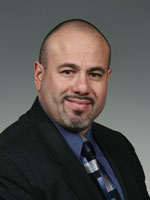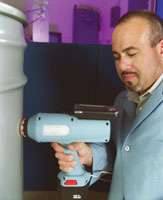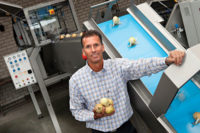
Aaron Diaz, senior research scientist, Pacific Northwest National Laboratory, Richland, WA. Source: Pacific Northwest National Laboratory.
Diaz graduated from the University of California, Santa Cruz with a B.S. in physics and immediately joined the staff at PNNL, where he initially applied his specialty in marine mammal sonar on lab projects involving underwater acoustics. Over the last 20 years, he worked in several of the lab’s research and technology development areas before focusing on ultrasonic and electromagnetic nondestructive examination measurements, imaging and analysis. He is project manager and principal scientist for acoustic inspection systems, a technology initially developed for US Customs inspectors, IRS fuel compliance officers and counter-terrorism and drug-interdiction officials. The lab also has worked to transfer acoustic inspection to food manufacturing.

Aaron Diaz uses a handheld acoustic inspection device to determine the contents in a 55-gallon drum. Portable devices using sound waves to inspect sealed containers were the initial focus of acoustical engineers, but now they are applying the technology to inline inspection of food and beverage products. Source: Pacific Northwest National Laboratory.
Diaz: In the wake of Operation Desert Storm in the early 1990s, the Defense Department needed a treaty verification device to spot munitions that contained chemical warheads. Over the next 10-12 years, we continued to invest in and develop the technology for a variety of applications. IRS inspectors use a handheld acoustic-inspection device to determine what type of fuel, its octane and other characteristics are inside tankers arriving at entry ports. We realized if we could inspect a tanker, we could determine the contents of a 55-gal. drum by measuring the speed, frequency and strength of sound waves.
FE: What was the first food application?
Diaz: In late 2001, we were approached by a poultry processor who wanted a way to detect bone and cartilage in chicken breasts moving through an enclosed pipe in a water and brine slurry. Product was moving 12-15 ft. a second. We combined both ultrasonic and optical capabilities, monitoring transmission and reflected energy to detect any foreign objects. It’s the only system we’re aware of that uses both acoustics and optics, and because it can be automated, it’s safer and more effective than manual inspection. It’s also faster and safer than X-ray.
Three years were spent looking at the acoustic and optical responses of cartilage, fat and meat. We had to determine the smallest particles the system could detect, quantify the density and shape of different elements, and determine the probability of detection and the probability of false alarms, then make the necessary tradeoffs.
There always is that gap between the R&D process and the application, where environmental and process constraints come into play. When the device was taken into the commercial space, the problem of air bubbles in the slurry surfaced. Air bubbles are highly reflective, in some cases even more reflective than glass and bone. In controlled lab conditions, we could detect bone fragments as small as one-eighth inch, but we finally determined that ultrasound wasn’t going to work commercially because of all the false alarms. We ended up with the world’s most expensive bubbles and bones device.
FE: Have air bubbles been a chronic problem in other food applications?
Diaz: Not at all. Acoustic inspection systems have been deployed successfully for inspection of tomato paste, which relies on an ultrasonic Doppler velocimeter. Other commercial applications have involved Slim Fast, cookie dough and rice, as well as nonfood products such as plastics and concrete. Ultrasound is being used successfully to determine fat content in ground beef.
FE: Near-infrared and other technologies also have proven successful for fat analysis, and metal detectors and X-rays are effective quality-assurance tools. Why should a manufacturer consider ultrasound?
Diaz: The robustness, operating cost and safety of ultrasound systems, and the amount of information you can get in real time, are major advantages. Ultrasound transducers last for years and years. They can cost anywhere from $50 to a few thousand dollars for custom transducers. It’s a mature technology, and readings of attenuation, backscatter and the speed of the sound yield both quantitative information on density, viscosity and particle size and qualitative information on size-reduction trends, foreign objects and other transient factors.
FE: At a recent food-industry forum, a PNNL official outlined a successful application developed for ConAgra’s Lamb Weston division. How was acoustic inspection useful in potato production?
Diaz: Passive acoustic sensors were installed to monitor the cutting blades for French fries. The knives generate acoustic emissions; by listening to the noise in the background or the blades themselves, it is possible to detect when the knife is nicked or is about to break. There is a change in the acoustic signature as the steel wears. By monitoring the signal, plant maintenance workers were able to replace the blades when they reached a certain level of performance.
Acoustic-emissions sensors are low-cost, and it’s technology that’s been around for a long, long time. Similar devices have been applied to potato blanching and other processes. In the lab, we’ve looked at using them to determine the amount of water in the core of red delicious apples.
FE: In 2006, the lab patented a process for nonobtrusive monitoring of liquid in a fermenter with ultrasonic backscattering. Was that project undertaken for a particular beverage client?
Diaz: My colleagues Brian Tucker and Dick Pappas were involved in the use of ultrasonic backscattering to monitor a fermentation process. It has intriguing possibilities, and we can prove the feasibility in the lab, but until we can hook up with a brewer or vintner who understands the quality or production-cost issues that this can resolve, we can’t correlate the ultrasonic signals with the information they need.
In a fermentation vat, there is a need to know the number of yeast cells by volume, their size and size distribution, cell viability and other factors for accurate control and product consistency. The typical way of doing this is to periodically draw samples and analyze them in a lab, which is time-consuming and creates an opportunity for contamination. With ultrasonic backscattering, a transducer is placed in the fermenter and transmits ultrasound toward a reflecting source. A portion of the ultrasound backscatters from cells between those points. The signals are processed and outputted to a controller, providing real-time information on the status of fermentation.
FE: High-power ultrasound is beginning to be used as a processing tool in commercial applications. Is the lab involved in some of that work?
Diaz: We are working with ultrasound-breakdown emulsified crude oil, using it to cleave chemical bonds in the oil. There also are potential applications in enzyme activation and deactivation, homogenization, crystallization, particle size reduction and other processes used in food and other industries.

